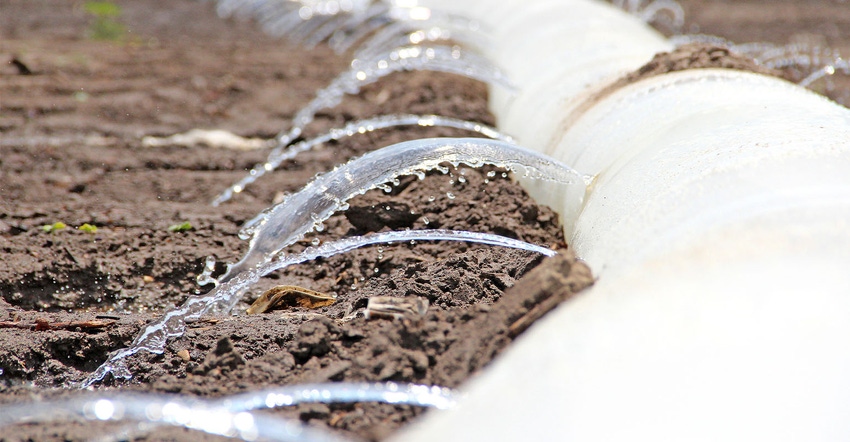
Irrigated cotton typically yields better than dryland cotton. However, there are irrigation management practices that can cause more harm than good, as well as irrigation practices to help decrease plant stress and increase yields.
Brian Pieralisi, Mississippi State University assistant professor and Extension cotton specialist, and Darrin Dodds, Mississippi State University Professor and Head for the Department of Plant and Soil Sciences, spoke on cotton irrigation, during the virtual 2021 National Conservation Systems Cotton and Rice Conference.
Root structure
Thanks to tools like soil moisture sensors, surge valves, and computerized hole selection, irrigation is more efficient. Even so, it is important to consider root structure when timing irrigation.
"Despite the tools we have, it's not uncommon to see a dryland portion of a given field out yield an irrigated portion of a field," Dodds said. "For those with pivot irrigation, I've heard several times, 'My dryland has out yielded my pivot irrigated acres. Why spend all this money running my pivot?' Or I hear, 'My dryland cotton did just as good as my irrigated, so why do I run water down the furrow three times?' There are a lot of reasons why that happens, and that is what complicates irrigation. It can be something as simple as you pulled the trigger too early on watering, and then the next day you got too much rainfall."
Keep in mind to adjust your irrigation strategy to accommodate a shallow-rooted crop.
"One facet we do not always take into consideration is the root structure of the cotton in a given year," he said. "Especially in a year like 2020, which was wet early on, I would argue we had a shallow-rooted crop. When the cottonseed was planted in the damp ground and started to grow, the rooting system did not have to go seeking out water deep in the ground like it would have if it had been drier."
Timing irrigation
It is important to have timely irrigation at first bloom to help eliminate plant stress.
"From an initiation standpoint of irrigation, you want to have your soil profile completely charged before first bloom," Pieralisi said. "This relieves a lot of stress on the plant. Everybody is worried about dropping squares and knocking squares off. I'll hear, 'I need to get my nitrogen out. I'll hold off on my irrigation until I get these jobs done.' However, that is when you run into a lot of plant stress. Keep in mind, protecting the bottom zones of the plant early by keeping your soil charged will benefit you later."
Dodds added that it pays to be timely with your first round of irrigation.
"Sometimes, we get delayed a little bit because of nitrogen application," Dodds said. "I would argue, if we are often late getting nitrogen out, we need to be rethinking our process.
"Nitrogen, from a nutrient standpoint, is one of the biggest impact factors. When cotton starts to demand a lot of nitrogen is usually when one of the squares starts setting up around 30 to 35 days after planting, so I would suggest a split application."
The first nitrogen application should go out around planting time or immediately thereafter, and then a second shot should go out about 30 days after the first.
"Have your irrigation ready to go four or five days before you know blooms are about to show up, so you are getting a shot of water down that row as soon as you need to," Dodds said. "When those blooms show up, as Brian indicated, you have a full profile of moist soil. When irrigation gets delayed, that is a big mistake.
"You cannot water everything across the board at the same time, so it usually takes a couple of weeks to get it all done. Inevitably, when we do this, we see squares piled up in tail ditches. The most critical aspect of cotton irrigation is getting water down the row right before first bloom, so your soil profile is full. Beyond that, we have a whole lot more flexibility."
Computerized hole selection
The two types of irrigation common in Mississippi and most of the Delta are pivot irrigation and furrow irrigation. With furrow irrigation becoming more prevalent, tools like computerized hole selection can help with efficiency.
"There are several tools to help aid in irrigation, namely computerized hole selection, surge irrigation, and soil moisture sensors," Pieralisi said. "The goal of what we are trying to do with these tools is to maximize our irrigation water use. Some people do not want to use all these, but if you're going to use one of these tools, go with computerized hole selection."
Dodds further emphasized that computerized hole selection is the easiest and the cheapest tool to invest time and money into.
"You will need to make some minor adjustments in the beginning, but it is especially beneficial for irregular-shaped fields," Dodds said. "Soil moisture sensors would be a close second out of irrigation tools I would consider looking into."
Although it may take some time to figure out computerized hole selection, you see results immediately from making the switch.
"Your water efficiency is going to go up," Pieralisi said. "You are going to be able to water irregularly shaped fields where you could not irrigate easily before. Surge irrigation, where you are switching between two irrigation sets, is not going to work for everyone. However, where it does fit, it works extremely well."
Pipe Planner is one example of a computerized hole selection program.
"What Pipe Planner does is pair flow rate to the field size to create the most efficient hole punch for that field," Pieralisi said. "We have also seen a return of investment anywhere from $10-$25 an acre. You are getting this back by decreasing your electricity use and conserving water. Additionally, you are saving time, and the whole irrigation process will be 30% more efficient."
Read more about:
Furrow IrrigationAbout the Author(s)
You May Also Like




